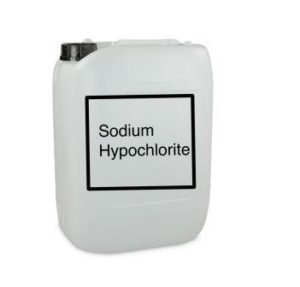Sodium Hypochlorite Usage in Disinfection which exhibits broad-spectrum antimicrobial activity and widely used in healthcare facilities in a variety of settings.
Sodium hypochlorite solution preparation formula
Usually diluted in water depending on its intended use. “Strong chlorine solution” with 0.5% solution of hypochlorite (containing approximately 5000 ppm free chlorine) used for disinfecting areas contaminated with
Body fluids, including large blood spills (the area, first cleaned with detergent before being disinfected). Made by diluting household bleach as appropriate (normally 1 part bleach to 9 parts water). Such solutions demonstrated to inactivate both C. difficult and HPV. “Weak chlorine solution” with 0.05% solution of hypochlorite used for washing hands, but normally prepared with calcium hypochlorite granules.
Dakin’s Solution mainly a disinfectant solution containing a low concentration of sodium hypochlorite and some boric acid or sodium bicarbonate to stabilize the pH. An effective solution with NaClO concentrations as low as 0.025%
US government regulations allow food processing equipment and food contact surfaces for sanitized with solutions containing bleach, provided that the solution that allows draining adequately before contact with food. The solutions do not exceed 200 parts per million (ppm) available chlorine (for example, one tablespoon of typical household bleach containing 5.25% sodium hypochlorite, per gallon of water). If higher concentrations used, the surface rinsed with potable water after sanitizing.
sodium hypochlorite solution Uses
A similar concentration of bleach in warm water used to sanitize surfaces prior to the brewing of beer or wine. Surfaces rinsed with sterilized (boiled) water to avoid imparting flavors to the brew; the chlorinated byproducts of sanitizing surfaces are also harmful. The mode of disinfectant action of sodium hypochlorite is similar to that of hypochlorous acid.
Sodium hypochlorite solution for disinfection
Solutions containing more than 500 ppm available chlorine corrosive to some metals, alloys, and many thermoplastics (such as acetyl resin). It needs to remove thoroughly after use, so the bleach disinfection sometimes followed by an ethanol disinfection.
Liquids containing sodium hypochlorite as the main active component also used for household cleaning and disinfection, for example, toilet cleaners. Some cleaners formulated to be viscous so as not to drain quickly from vertical surfaces, such as the inside of a toilet bowl. The un-dissociated (non-ionized) hypochlorous acid believed to react with and inactivate bacterial and Neutrophils of the human immune system. Neu produces small amounts of hypochlorite inside phagosomes, which digest bacteria and viruses.
I did not find a single way of use sodium hypochlorite in hospital
Can i use Sodium hypochloride for pit toilet?
Sodium hypochlorite is used as a surface disinfectant maximum used in hospitals and healthcare clinics for the purpose of cleaning floor and wall. It is not recommended to used for cleaning toilet.